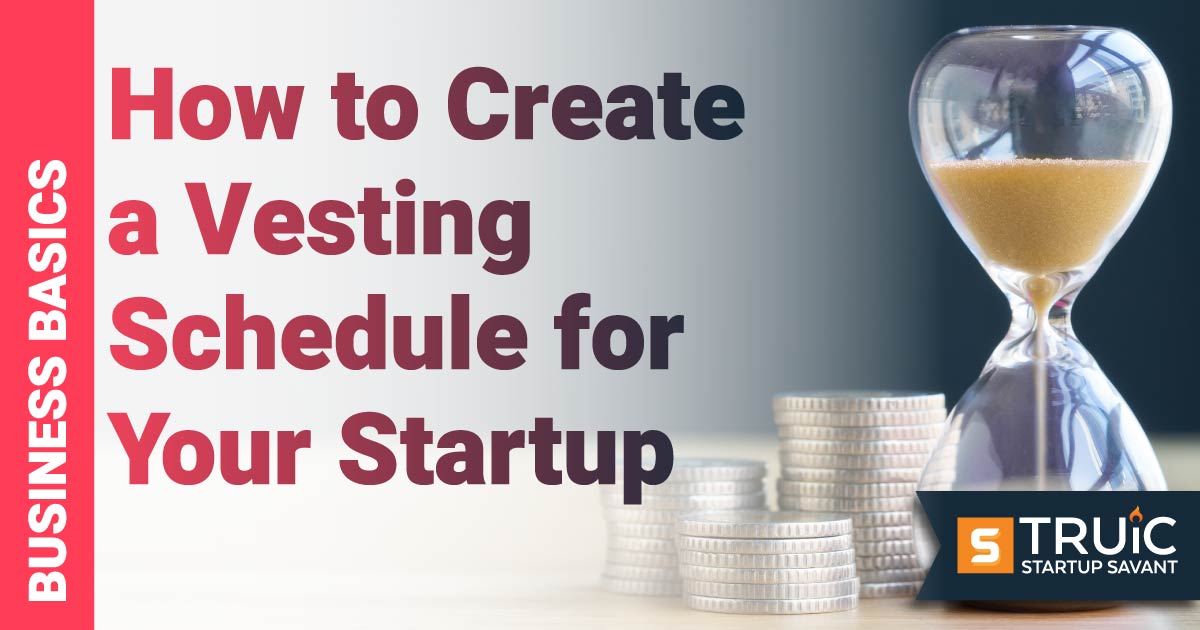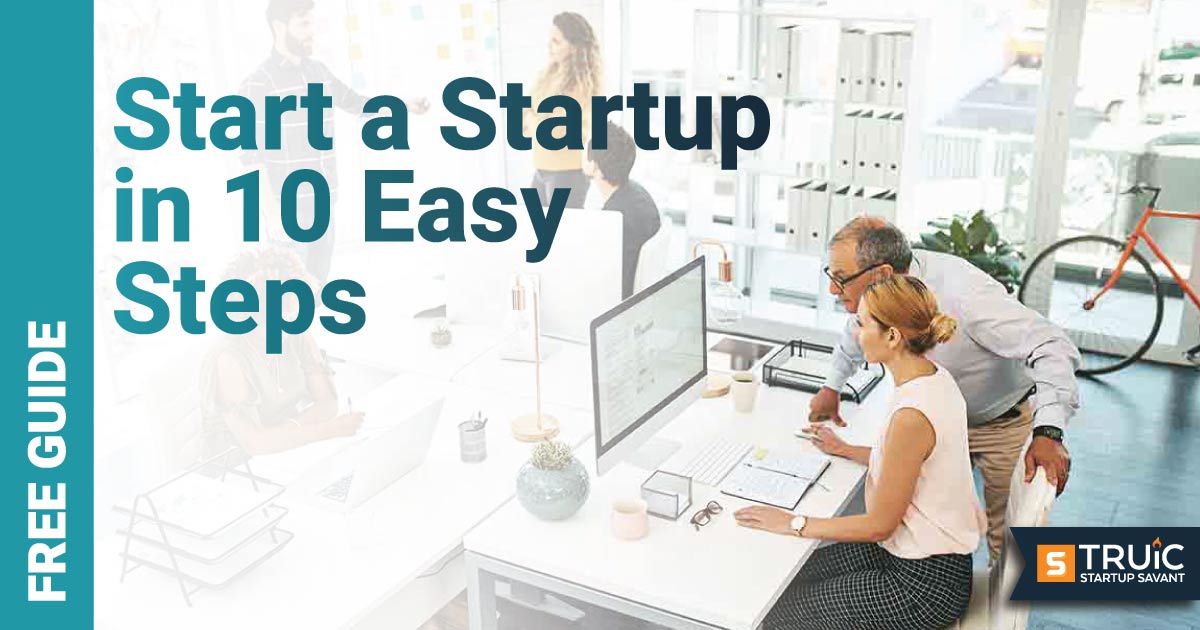How to Create a Vesting Schedule for Your Startup

Last Updated: By TRUiC Team
Vesting is an important concept that all entrepreneurs will need to consider when incorporating their startup and whenever they grant equity to key employees, directors, advisors, and other stakeholders of the company.
Vesting is a tool that a startup can use to protect its equity and interests while leveraging this equity to launch and grow the firm. In this guide, we will tell you everything you need to know to create a vesting schedule for your startup.
Building a Vesting Schedule
Before diving in, it's vital to grasp the essence of a vesting schedule. It's a timeline dictating when stakeholders (usually founders, employees, or investors) can exercise (or fully own) their stock options or shares. Think of it as a reward system that ensures long-term alignment and dedication. It's crucial because granting equity upfront might lead to complications if a key member leaves prematurely.
For a more thorough understanding, see our guide on vesting and how it works.
Now, let’s break down how to craft the perfect vesting schedule for your startup.
Jump Ahead:
1. Determine the Purpose of the Vesting Schedule
Before you can draft a vesting schedule, it's essential to understand and clearly define its purpose. Why are you implementing one? What objectives does your startup aim to achieve with it?
Here are some of the key reasons and purposes behind establishing a vesting schedule:
- Retain Talent: Incentivize and ensure long-term commitment from key employees.
- Protect Interests: Safeguard the startup from potential setbacks if key members depart early.
- Align Goals: Encourage long-term thinking and dedication to the company's vision.
- Facilitate Investments: Show potential investors the startup's structured approach to handling equity and commitment.
Once the purpose is clear, crafting the terms and details of the vesting schedule becomes a more straightforward process.
2. Decide on the Type of Equity
Understanding and choosing the appropriate type of equity is paramount for startups, as it defines the rights and benefits associated with that equity. Here are the primary equity types to consider:
Common Stock
Typically issued to founders, employees, and advisors, common stock represents ownership in the company. It grants voting rights but generally stands behind preferred stock in terms of payouts during exits or liquidation.
Preferred Stock
Often favored by investors, preferred stock provides certain privileges not given to common stockholders, like priority during payouts. They usually do not come with voting rights.
Stock Options
Stock options are essentially an offer from a company, granting individuals the right (but not the obligation) to buy a certain number of shares in the company at a predetermined price, known as the strike price.
Employees may purchase the stock at the strike price after the options vest, usually based on how long the employee works at the company. If the market price of the stock rises above the strike price, employees can buy shares cheaper than the market price and make a profit.
Restricted Stock Units (RSUs)
RSUs are commitments to grant a set number of shares at specific future dates. These "vest" over time, meaning employees receive the underlying shares after meeting certain conditions, often tied to employment duration or performance milestones.
Unlike stock options, employees do not need to purchase RSUs.
Phantom Stock
Phantom stock is a compensation agreement that gives employees the right to receive cash payments equivalent to the value of a specified number of company shares. Unlike actual company stock, phantom stock does not represent legal ownership in the company. The cash value paid out on phantom stock is tied to the market price of the company's stock, granting employees similar benefits without diluting company ownership.
Stock Appreciation Rights (SARs)
Stock appreciation rights allow employees to receive cash or shares equal to the appreciation in company stock from a predetermined strike price. SARs are issued with a strike price set at the time of grant and vest over a period of time, just like stock options. Once SARs vest, employees can exercise them and receive cash or shares based on the increase in stock price compared to the strike price.
Each equity type offers distinct advantages and considerations, so choose in alignment with your startup's objectives and stakeholder preferences.
3. Define the Total Amount of Equity
Decide on the total number of shares or stock options you’ll be allocating to employees, founders, and others. This number not only impacts your company's present value but also influences future funding rounds and equity distribution. Here's how you can define this:
- Company Valuation: Begin with a realistic assessment of your startup's current worth. This could be self-assessed or professionally evaluated.
- Founder Equity: Allocate shares to the founders, keeping in mind their roles, responsibilities, and contributions. Typically, founders may reserve between 40% to 60% of total equity.
- Employee Pool: Set aside equity for current and future employees. Standard practice is reserving 10% to 20% for an employee stock option pool.
- Investor Shares: Anticipate future funding rounds. Decide what percentage you're willing to offer to investors.
- Advisors and Board Members: They bring expertise and networks, so allocate a portion for them, usually between 1% to 5%.
- Miscellaneous: Ensure you have some equity set aside for unforeseen opportunities or partnerships.
Once you've broken down these categories, ensure the allocations don't exceed 100%. It's a balancing act, so revisiting and adjusting as your startup grows and evolves is crucial.
4. Choose a Vesting Period
The industry standard for vesting is typically 4 years, with a one-year "cliff." This means that no equity vests in the first year, but a significant portion (often 25%) does so at the one-year mark. Here are some additional factors to keep in mind during this step:
- Role Considerations: Senior roles or critical hires might negotiate shorter vesting periods, while advisory roles could have longer or varied vesting timelines.
- Performance-based Vesting: Instead of time, vesting can be tied to achieving specific milestones or goals, such as product launches or revenue targets.
- Investor Expectations: Some investors might have preferences or requirements regarding vesting periods. Engage in open dialogue to ensure alignment.
- Flexibility: While it's crucial to set a clear vesting timeline, being open to renegotiations for exceptional candidates or changing business dynamics can be beneficial.
5. Determine a Cliff Period
The cliff period refers to the duration an employee or stakeholder must remain with the company before any portion of their equity starts to vest. As mentioned previously, the typical cliff period is one year. This is a time-tested approach to ensure that new hires are genuinely committed.
For key positions or specialized roles, consider adjusting the cliff period. A shorter cliff might act as an incentive, while a longer one ensures more extended commitment.
It’s also important to consider contractual obligations during this step. In some cases, previous agreements or investor stipulations may influence the cliff's duration.
Remember that cliffs, like other equity terms, can be negotiable, especially when trying to attract top-tier talent.
6. Set the Vesting Frequency
At its core, vesting frequency is all about pacing. It dictates how often a portion of the equity becomes available to stakeholders.
Monthly or quarterly vesting is common after the cliff period. Imagine an employee with a 48-month vesting period and a 12-month cliff for 48,000 shares. If you're on a monthly schedule after the cliff, they'd receive 1,000 shares each month for the remaining 36 months.
However, what if your startup operates in cycles, perhaps with major projects wrapping up quarterly? In such cases, you might opt for quarterly vesting. Using the same example, post-cliff, the employee would receive 12,000 shares every three months.
Some companies even prefer an annual rhythm, especially if their business model or milestones revolve around yearly benchmarks. In this scenario, the same employee would get 36,000 shares all at once, one year after the cliff.
Of course, external agreements, like those with investors, might nudge you toward a particular frequency. And remember, it's always beneficial to chat with potential hires or significant team members about their preferences. They might have insights or prior experiences that could guide your decision.
7. Consider Accelerated Vesting Provisions
Accelerated vesting is a bit like a fast-forward button for equity. It allows shares to vest sooner than the original schedule dictates, often triggered by specific events. For instance, if your company gets acquired or if an employee is let go without cause.
Imagine a key employee is three years into a four-year vesting schedule when your startup gets acquired. Accelerated vesting provisions could enable this employee's remaining equity to vest immediately due to the acquisition, recognizing their contributions and ensuring they benefit from the event.
But accelerated vesting isn't just a protective mechanism. It can also serve as a persuasive tool when negotiating with potential hires or during investment talks. High-caliber talent or seasoned investors might request these provisions as part of their terms.
While it can be a valuable tool, accelerated vesting can also complicate future fundraising or acquisition talks. Balancing its strategic advantages with potential future implications is key. Make sure to consult with legal and financial advisors to ensure you're making the right decisions.
8. Draft the Vesting Agreement
After ironing out the specifics of the vesting schedule, it's time to put pen to paper. Drafting a vesting agreement is a meticulous process where precision and clarity are paramount. This document not only ensures everyone is on the same page but also serves as a legal safeguard for all parties involved.
Hire a Legal Professional
While you may have a clear vision of how equity distribution should play out, translating that into legal jargon requires expertise. A misstep or oversight here could lead to complications down the line. Hiring a lawyer, especially one with experience in startups or equity agreements, is a wise move. They'll ensure your terms are clear, fair, and legally sound.
Cover All Bases
Your agreement should detail every aspect of the vesting schedule, from the total equity amount to the frequency and any provisions for accelerated vesting. It should also outline the responsibilities and expectations of each stakeholder.
For reference, here is an example of a vesting agreement. While this can provide a foundational understanding, remember that your agreement should be tailored to your startup's unique needs and circumstances.
Invest in Equity Management Software
As your startup grows, manually tracking equity can become an overwhelming task. It's smart to invest in equity management software, such as Carta or Pulley, from the get-go. These platforms allow you to seamlessly track and manage equity distribution, ensuring that everything runs smoothly and transparently. The automation and reporting capabilities streamline a very complex process.
9. Review and Revise Periodically
As your company grows, strategies shift, or new challenges arise, it's crucial to ensure that your agreement remains relevant and reflective of current realities.
Align with Business Evolution
Businesses, especially startups, are in constant flux. You might pivot, scale, or diversify. Regular reviews ensure your vesting agreement stays congruent with your startup's direction and objectives.
Solicit Feedback
Your team's insights can offer fresh perspectives on the vesting process. Encourage open discussions. Feedback might highlight areas of the agreement that need fine-tuning or updating.
Stay Tech-Savvy
If you're using equity management software, ensure it's the latest version. Regular software updates can streamline the review process and offer enhanced features.
Establish a Review Cadence
Setting a fixed schedule, like biannual or annual reviews, keeps the process systematic and ensures you don't overlook any crucial updates.
10. Stay Compliant
Compliance isn't just about adhering to current regulations—it's about fostering trust and transparency within your startup and with external stakeholders.
- Monitor Legal Changes: Regulations around equity, business operations, and corporate governance can change. Regularly liaise with legal professionals to stay updated and ensure your agreement meets all legal benchmarks.
- Engage Experts: Legal complexities can be daunting. Working closely with legal experts ensures that your agreement is not only compliant but also robust against potential future challenges.
- Document Everything: Proper documentation of every revision and update to your vesting agreement is crucial. In the event of disputes or audits, having a clear paper trail can be invaluable.
- Educate Your Team: Ensure that everyone, from founders to new hires, understands the implications of the vesting agreement and the importance of compliance. Regular workshops or training sessions can help in this regard.


